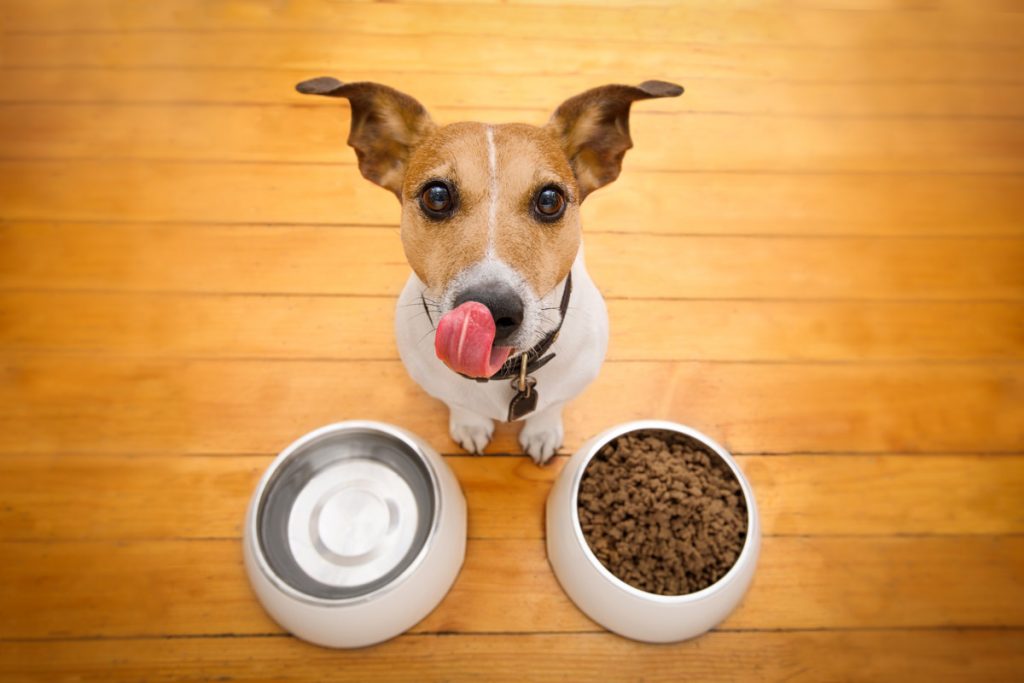by Timothy Moore
Contributor
From a gallon of gas to a gallon of milk, the cost of everything is going up. The price of caring for our pets has not been immune to rampant inflation.
A 2022 survey conducted by Rover found that 71% of dog owners say their pet care costs have gone up due to inflation. And these costs are affecting most families across the US: More than seven in 10 households include at least one pet in the family, according to a recent American Pet Products Survey.
And with nearly every pet owner (95%) considering their dog, cat or other pet part of the family, people are more willing than ever to spend money on high-quality pet food, veterinary care, enrichment opportunities and other facets of pet ownership.
So how do you ensure your pet is eating quality food to get the nutrition they need without maxing out your credit card or overdrafting your checking account to do so? We’ve put together a few easy ways to save money on pet food that will help keep your bills down, even in the face of rising costs.
9 Ways to Save Money on Dog Food
- Talk to your vet about options
- Make dog food at home
- Mix dog food brands together
- Don’t overfeed
- Buy in bulk
- Join a store’s discount program
- Save with autoship
- Look for coupons
- Use a cash back rewards card
Your dog’s food can be expensive, especially for premium pet foods that are often billed as being better for your dog’s health. But if you’re caring for a dog on a budget, you’re going to want to find some unique ways to save money on pet food. Here are nine of our favorites:
1. Talk to Your Vet About Options
The dog food aisles at pet stores can be overwhelming — there are so many options, and many of them are pricey. You might be tempted to pick the most expensive organic dog food brand, assuming it offers the best nutrition for your pet, but that might not be the case.
Chat with your vet about their pet food recommendations within your target budget. They should be able to give you options within your price range and may even have special insights on what your specific dog needs based on breed, coat, age, weight or health conditions.
And you don’t have to wait for your next vet appointment to ask. Just call the office and ask the front desk if the vet can offer some recommendations. Some vets might even have an email address you can contact.
2. Make Dog Food at Home
Homemade dog food can be more affordable, but it’s crucial that you work with your vet to ensure the food you make ticks all the boxes for your pet’s health.
The diet needs to include a lot of high-protein ingredients, like meat and fish. Rice, oatmeal, carrots, sweet potatoes, green beans and peas are good fillers to make the food stretch, but the key to keeping a carnivore happy is loading their belly with plenty of meat.
Right now, meat is expensive, but you can look for meat that’s on sale or that is less desirable for the human palate, like chicken liver and lean ground turkey.
Make sure the meal is well-balanced with protein, fats and fatty acids, carbohydrates, fiber, vitamins and minerals. You may need to purchase supplements to ensure your dog’s diet is balanced. But these supplements can get expensive; an alternative is mixing in some dry food that offers the necessary minerals and fats your dog needs.
3. Mix Dog Food Brands Together
If your vet has identified a food that offers a high level of protein and fats that are beneficial for your dog’s diet — but it’s a little too expensive — ask about mixing it in with a more affordable dog food as a “filler” to make the premium food last longer.
Just ensure the filler brand is still of good quality (hint: meat should be the first ingredient!).

4. Don’t Overfeed
According to recent AKC statistics, 56% of dogs are overweight or obese. That means more than half of us are feeding our pups more than they need.
Of course, the first way to address obesity in dogs is to stop feeding table scraps and extra treats and ensure they are getting enough daily exercise.
But you should also ask your vet for your dog’s ideal weight and feed the right amount of dry food based on that weight. Just check the back of the bag to see how much you should be scooping out each day.
5. Buy in Bulk
Larger bags of dog food typically cost less per ounce. If you have multiple dogs (or a larger dog), getting a large bag is a no-brainer.
But even if you have a smaller pooch, it can make sense in the long run to buy the big bag. Just make sure you have an airtight container to store it in.
Members of wholesale clubs like Costco and Sam’s can find even better deals on bigger bags. But before you buy dog food at one of these stores, research the brands and ask your veterinarian for their thoughts.
6. Join a Store’s Discount Program
Many pet store chains and even local pet stores offer rewards or loyalty programs. A regional store in Ohio called PetPeople uses a punch card to earn free bags of dog food while national chains like PetSmart let you earn points for every purchase.
7. Save With Autoship
Shopping in-person at pet stores allows you to more easily compare brands and ask questions — and you can usually bring your furry friend along with you.
But these stores can also be more expensive. Shopping for pet food online and opting into a subscription (also called autoship) can save you money and might be more convenient to boot.
Chewy, for example, offers 35% off (up to $20) on your first autoship. You’ll then get 5% off every future autoship. You can set the schedule for the shipments based on how often you typically need a new bag of food, and you can go in and change the frequency any time (like when you add a new dog to the family).
PetFlow is another online shop to consider. Even physical stores like PetSmart, Pet Supplies Plus and Petco offer autoship options online.
Amazon is also in the pet food game. Prime members might find Amazon to be the most convenient and economical option of all. You can find pet food brands like Purina, Blue Buffalo, Pedigree, Iams, Taste of the Wild, CANIDAE and Nature’s Recipe on the e-commerce platform.
8. Look for Coupons
When you join a loyalty program with a specific pet store, you’ll usually get coupons emailed to you. But you can also be proactive and search for coupons online and ask for them when you walk into the store.
The savings may not be huge — maybe just a couple bucks off a bag — but every little bit helps.
9. Use a Cash Back Rewards Card
Cash back rewards aren’t just a way to save money on dog food; they’re a way to save money on everyday purchases. Whether it’s paying to pump at the gas station, buying groceries for the week or getting movie tickets, swiping a cash back rewards debit or credit card can earn you money (usually between 1% and 2%), points to redeem or travel miles.
Not sure which card to go with? Here are some of our favorite checking accounts, some of which offer cash back rewards. Varo is our favorite for cash back; check out our full Varo Bank review for details.
You Can Save Money on Cat Food, Too
This piece focuses on how to save money on dog food, but these tips apply for your feline friends as well. You can join autoship and discount programs for cheaper cat food, clip coupons and pay attention to your cat’s weight.
The biggest difference is in making your own cat food. Homemade cat food recipes will differ from dog food recipes, just based on their differing nutritional needs. But whether for a dog or cat, always ask your vet for tips when making your own pet food.
And even if you plan to buy pet food rather than make it, consult with your veterinarian to hear their recommendations for your cat.
How to Change Your Pet’s Diet
Transitioning your dog or cat from one pet food to another is a delicate process that can’t be done in a single day. In fact, you should slowly transition from one food to the other over the course of 10 days.
Pet Food Transition Timeline
- Days 1-3: Feed 75% old food mixed with 25% new food.
- Days 4-6: Feed 50% old food mixed with 50% new food.
- Days 7-9: Feed 25% old food mixed with 75% new food.
- Day 10: Completely switch to the new dog food or cat food.
Why should you slowly transition your dog or cat from one food to another? A fast, immediate switch from one dog food or cat food to another can upset your pet’s stomach and lead to serious gastrointestinal issues.
A slower transition also lets you watch for any reactions to the food. If your pooch winds up being allergic to the new dog food, for example, the effects won’t be as detrimental since you’ve been exposing them to a smaller amount.
Buying Smaller Bags
Because you never know how your pet will react to a new food, it actually makes more sense to buy a smaller batch when transitioning. As we discussed above, buying in bulk can lead to more savings per ounce, but if your dog winds up being allergic to the new food and you have to donate it to a local shelter, you won’t be out as much as you would have been had you opted for the large, economical bag.
In fact, your vet might even be able to offer you a free sample during the transition. However, veterinary samples are typically for special diets they carry in their office, which will cost much more than food purchased online or at a pet store.

Other Ways to Save Money on Pet Care
Pet food costs are one of the largest pet care expenses to budget for, but there are other costs to consider, such as health care, training, grooming, enrichment and even services like pet sitting or dog walking when traveling or working long days.
Here are a few ways to save money on pet care:
Consider Pet Insurance
The cost of veterinary care is on the rise, and pet parents are more willing than ever to spend money on the medical care their pets require. In fact, 47% of pet parents say they have taken on some kind of pet-related debt, per a LendingTree survey.
While pet insurance can be expensive, it can at least help you feel more comfortable about getting the care your pet needs in the case of an emergency or serious illness. We’ve rounded up the best pet insurance companies in the business to help you start your search.
Autoship All Your Needs
Autoship works for more than just pet food. From flea preventative to dog shampoo to heartworm meds to prescriptions that your pet might need for the rest of their life, autoship can be a great source of savings.
Get Meds Online
Speaking of meds, the cost of pet medications is as expensive as, well, people medications. Try shopping online through pet medication distributors to save money when filling prescriptions. Some of our favorites are:
Go the DIY Route
From toys to grooming, you can attempt to do it all yourself. Less complicated dogs (i.e., not poodles) are good candidates for grooming at home. At the very least, you can get comfortable trimming your own dog’s nails.
And rather than buy a bunch of expensive toys, try out some DIY cat toys and DIY dog toys.
If you feel confident and do enough research, you can even train a new dog yourself. (If your dog has behavioral problems, however, it is best to work with a trained professional.)
Trade Services With Other Dog Owners
If you watch a friend’s dog or check in on a family member’s cat when they go out of town, they’re more likely to return the favor during your next trip. Similarly, you and a neighbor could take turns going home at lunch to let each other’s dogs out and take them for a walk.
Before trading such services with other pet owners, observe them with their own pet. If they display quality care for their pet, you can trust they’ll take good care of yours as well.
Frequently Asked Questions (FAQs) About Saving Money on Dog Food
Have questions about how to save money on dog food? Here are some of the top questions our readers are asking — with quick, helpful answers.
It is possible to save money by making your dog’s food, especially if you are able to buy meat in bulk at discount prices and have room in your freezer. Just talk to your vet about how to create a balanced diet for your pet when making food on your own.
The 25% rule in dog food means that the ingredient named (like chicken, beef, lamb, or salmon) must make up at least 25% of the product. So if the food is called “Chicken Dinner” or “Chicken Formula,” at least 25% of the total ingredients must be chicken to comply with rules established by the Association of American Feed Control Officials (AAFCO).
Buying a low-quality dry dog food is the cheapest option for your dog, but it is certainly not the best for your dog’s health. When comparing the cost of homemade food to high-quality dog food, it is possible to save money by making food at home that offers the same quality. Talk with your vet about your pet’s dietary needs to formulate a homemade diet.
Each dog has its own unique dietary needs based on age, weight, breed and health conditions. There is no single top brand that every expert or vet agrees on, but Dog Food Advisor is a good way to compare reviews and ratings. That said, your vet is the best person to talk to about picking a diet specifically for your dog.
You can mix dog foods together to make a premium dog food stretch a little further. Make sure the food you are mixing it with is designed for a dog of the same life stage (i.e., don’t mix a puppy formula with a senior formula). When choosing a “filler” dog food to mix in, ensure you are still picking a food of moderate quality approved by your veterinarian.
Contributor Timothy Moore is a writer and editor in Cincinnati, Ohio. He focuses on banks, loans and insurance for The Penny Hoarder. His work has been featured on Debt.com, The Ladders, Glassdoor, WDW Magazine, Angi and The News Wheel.
From a gallon of gas to a gallon of milk, the cost of everything is going up. The price of caring for our pets has not been immune to rampant inflation.
A 2022 survey conducted by Rover found that 71% of dog owners say their pet care costs have gone up due to inflation. And these costs are affecting most families across the US: More than seven in 10 households include at least one pet in the family, according to a recent American Pet Products Survey.
And with nearly every pet owner (95%) considering their dog, cat or other pet part of the family, people are more willing than ever to spend money on high-quality pet food, veterinary care, enrichment opportunities and other facets of pet ownership.
So how do you ensure your pet is eating quality food to get the nutrition they need without maxing out your credit card or overdrafting your checking account to do so? We’ve put together a few easy ways to save money on pet food that will help keep your bills down, even in the face of rising costs.
Your dog’s food can be expensive, especially for premium pet foods that are often billed as being better for your dog’s health. But if you’re caring for a dog on a budget, you’re going to want to find some unique ways to save money on pet food. Here are nine of our favorites:
The dog food aisles at pet stores can be overwhelming — there are so many options, and many of them are pricey. You might be tempted to pick the most expensive organic dog food brand, assuming it offers the best nutrition for your pet, but that might not be the case.
Chat with your vet about their pet food recommendations within your target budget. They should be able to give you options within your price range and may even have special insights on what your specific dog needs based on breed, coat, age, weight or health conditions.
And you don’t have to wait for your next vet appointment to ask. Just call the office and ask the front desk if the vet can offer some recommendations. Some vets might even have an email address you can contact.
Homemade dog food can be more affordable, but it’s crucial that you work with your vet to ensure the food you make ticks all the boxes for your pet’s health.
The diet needs to include a lot of high-protein ingredients, like meat and fish. Rice, oatmeal, carrots, sweet potatoes, green beans and peas are good fillers to make the food stretch, but the key to keeping a carnivore happy is loading their belly with plenty of meat.
Right now, meat is expensive, but you can look for meat that’s on sale or that is less desirable for the human palate, like chicken liver and lean ground turkey.
Make sure the meal is well-balanced with protein, fats and fatty acids, carbohydrates, fiber, vitamins and minerals. You may need to purchase supplements to ensure your dog’s diet is balanced. But these supplements can get expensive; an alternative is mixing in some dry food that offers the necessary minerals and fats your dog needs.
If your vet has identified a food that offers a high level of protein and fats that are beneficial for your dog’s diet — but it’s a little too expensive — ask about mixing it in with a more affordable dog food as a “filler” to make the premium food last longer.
Just ensure the filler brand is still of good quality (hint: meat should be the first ingredient!).
According to recent AKC statistics, 56% of dogs are overweight or obese. That means more than half of us are feeding our pups more than they need.
Of course, the first way to address obesity in dogs is to stop feeding table scraps and extra treats and ensure they are getting enough daily exercise.
But you should also ask your vet for your dog’s ideal weight and feed the right amount of dry food based on that weight. Just check the back of the bag to see how much you should be scooping out each day.
Larger bags of dog food typically cost less per ounce. If you have multiple dogs (or a larger dog), getting a large bag is a no-brainer.
But even if you have a smaller pooch, it can make sense in the long run to buy the big bag. Just make sure you have an airtight container to store it in.
Members of wholesale clubs like Costco and Sam’s can find even better deals on bigger bags. But before you buy dog food at one of these stores, research the brands and ask your veterinarian for their thoughts.
Many pet store chains and even local pet stores offer rewards or loyalty programs. A regional store in Ohio called PetPeople uses a punch card to earn free bags of dog food while national chains like PetSmart let you earn points for every purchase.
Shopping in-person at pet stores allows you to more easily compare brands and ask questions — and you can usually bring your furry friend along with you.
But these stores can also be more expensive. Shopping for pet food online and opting into a subscription (also called autoship) can save you money and might be more convenient to boot.
Chewy, for example, offers 35% off (up to $20) on your first autoship. You’ll then get 5% off every future autoship. You can set the schedule for the shipments based on how often you typically need a new bag of food, and you can go in and change the frequency any time (like when you add a new dog to the family).
PetFlow is another online shop to consider. Even physical stores like PetSmart, Pet Supplies Plus and Petco offer autoship options online.
Amazon is also in the pet food game. Prime members might find Amazon to be the most convenient and economical option of all. You can find pet food brands like Purina, Blue Buffalo, Pedigree, Iams, Taste of the Wild, CANIDAE and Nature’s Recipe on the e-commerce platform.
When you join a loyalty program with a specific pet store, you’ll usually get coupons emailed to you. But you can also be proactive and search for coupons online and ask for them when you walk into the store.
The savings may not be huge — maybe just a couple bucks off a bag — but every little bit helps.
Cash back rewards aren’t just a way to save money on dog food; they’re a way to save money on everyday purchases. Whether it’s paying to pump at the gas station, buying groceries for the week or getting movie tickets, swiping a cash back rewards debit or credit card can earn you money (usually between 1% and 2%), points to redeem or travel miles.
Not sure which card to go with? Here are some of our favorite checking accounts, some of which offer cash back rewards. Varo is our favorite for cash back; check out our full Varo Bank review for details.
This piece focuses on how to save money on dog food, but these tips apply for your feline friends as well. You can join autoship and discount programs for cheaper cat food, clip coupons and pay attention to your cat’s weight.
The biggest difference is in making your own cat food. Homemade cat food recipes will differ from dog food recipes, just based on their differing nutritional needs. But whether for a dog or cat, always ask your vet for tips when making your own pet food.
And even if you plan to buy pet food rather than make it, consult with your veterinarian to hear their recommendations for your cat.
Transitioning your dog or cat from one pet food to another is a delicate process that can’t be done in a single day. In fact, you should slowly transition from one food to the other over the course of 10 days.
Why should you slowly transition your dog or cat from one food to another? A fast, immediate switch from one dog food or cat food to another can upset your pet’s stomach and lead to serious gastrointestinal issues.
A slower transition also lets you watch for any reactions to the food. If your pooch winds up being allergic to the new dog food, for example, the effects won’t be as detrimental since you’ve been exposing them to a smaller amount.
Because you never know how your pet will react to a new food, it actually makes more sense to buy a smaller batch when transitioning. As we discussed above, buying in bulk can lead to more savings per ounce, but if your dog winds up being allergic to the new food and you have to donate it to a local shelter, you won’t be out as much as you would have been had you opted for the large, economical bag.
In fact, your vet might even be able to offer you a free sample during the transition. However, veterinary samples are typically for special diets they carry in their office, which will cost much more than food purchased online or at a pet store.
Pet food costs are one of the largest pet care expenses to budget for, but there are other costs to consider, such as health care, training, grooming, enrichment and even services like pet sitting or dog walking when traveling or working long days.
Here are a few ways to save money on pet care:
The cost of veterinary care is on the rise, and pet parents are more willing than ever to spend money on the medical care their pets require. In fact, 47% of pet parents say they have taken on some kind of pet-related debt, per a LendingTree survey.
While pet insurance can be expensive, it can at least help you feel more comfortable about getting the care your pet needs in the case of an emergency or serious illness. We’ve rounded up the best pet insurance companies in the business to help you start your search.
Autoship works for more than just pet food. From flea preventative to dog shampoo to heartworm meds to prescriptions that your pet might need for the rest of their life, autoship can be a great source of savings.
Speaking of meds, the cost of pet medications is as expensive as, well, people medications. Try shopping online through pet medication distributors to save money when filling prescriptions. Some of our favorites are:
From toys to grooming, you can attempt to do it all yourself. Less complicated dogs (i.e., not poodles) are good candidates for grooming at home. At the very least, you can get comfortable trimming your own dog’s nails.
And rather than buy a bunch of expensive toys, try out some DIY cat toys and DIY dog toys.
If you feel confident and do enough research, you can even train a new dog yourself. (If your dog has behavioral problems, however, it is best to work with a trained professional.)
If you watch a friend’s dog or check in on a family member’s cat when they go out of town, they’re more likely to return the favor during your next trip. Similarly, you and a neighbor could take turns going home at lunch to let each other’s dogs out and take them for a walk.
Before trading such services with other pet owners, observe them with their own pet. If they display quality care for their pet, you can trust they’ll take good care of yours as well.
Have questions about how to save money on dog food? Here are some of the top questions our readers are asking — with quick, helpful answers.
It is possible to save money by making your dog’s food, especially if you are able to buy meat in bulk at discount prices and have room in your freezer. Just talk to your vet about how to create a balanced diet for your pet when making food on your own.
The 25% rule in dog food means that the ingredient named (like chicken, beef, lamb, or salmon) must make up at least 25% of the product. So if the food is called “Chicken Dinner” or “Chicken Formula,” at least 25% of the total ingredients must be chicken to comply with rules established by the Association of American Feed Control Officials (AAFCO).
Buying a low-quality dry dog food is the cheapest option for your dog, but it is certainly not the best for your dog’s health. When comparing the cost of homemade food to high-quality dog food, it is possible to save money by making food at home that offers the same quality. Talk with your vet about your pet’s dietary needs to formulate a homemade diet.
Each dog has its own unique dietary needs based on age, weight, breed and health conditions. There is no single top brand that every expert or vet agrees on, but Dog Food Advisor is a good way to compare reviews and ratings. That said, your vet is the best person to talk to about picking a diet specifically for your dog.
You can mix dog foods together to make a premium dog food stretch a little further. Make sure the food you are mixing it with is designed for a dog of the same life stage (i.e., don’t mix a puppy formula with a senior formula). When choosing a “filler” dog food to mix in, ensure you are still picking a food of moderate quality approved by your veterinarian.
Contributor Timothy Moore is a writer and editor in Cincinnati, Ohio. He focuses on banks, loans and insurance for The Penny Hoarder. His work has been featured on Debt.com, The Ladders, Glassdoor, WDW Magazine, Angi and The News Wheel.
Ready to stop worrying about money?
Get the Penny Hoarder Daily
Privacy Policy
© 2022 The Penny Hoarder. – All rights reserved.
Privacy Policy and Terms of Service | Do Not Sell My Personal Information | Cookies Settings






